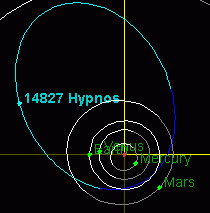14827 Hypnos
| Discovery | |
|---|---|
| Discovered by |
Carolyn S. Shoemaker Eugene Merle Shoemaker |
| Discovery date | 5 May 1986 |
| Designations | |
| MPC designation | 14827 Hypnos |
Named after | Hypnos |
| 1986 JK | |
| Apollo asteroid | |
| Orbital characteristics[1] | |
| Epoch 13 January 2016 (JD 2457400.5) | |
| Uncertainty parameter 0 | |
| Observation arc | 5288 days (14.48 yr) |
| Aphelion | 4.7325 AU (707.97 Gm) (Q) |
| Perihelion | 0.95025 AU (142.155 Gm) (q) |
| 2.8414 AU (425.07 Gm) (a) | |
| Eccentricity | 0.66557 (e) |
| 4.79 yr (1749.4 d) | |
| 83.236° (M) | |
| 0° 12m 20.808s / day (n) | |
| Inclination | 1.9809° (i) |
| 57.977° (Ω) | |
| 238.12° (ω) | |
| Earth MOID | 0.0147101 AU (2.20060 Gm) |
| Jupiter MOID | 0.520555 AU (77.8739 Gm) |
| Jupiter Tisserand parameter | 2.934 |
| Physical characteristics | |
| Dimensions | 0.9[1] - 1.2[2] km |
Mean radius | 0.45 km |
| <0.067[1][3] | |
| 18.3[1] | |
|
| |
14827 Hypnos (also known by its provisional designation 1986 JK) is an Apollo near-Earth asteroid (NEA) discovered by Carolyn S. Shoemaker and Eugene Merle Shoemaker at Palomar Observatory on May 5, 1986. It is named after Hypnos, the Greek god of sleep.
Hypnos may be the nucleus of an extinct comet that is covered by a crust several centimeters thick that prevents any remaining volatiles from outgassing.[4] Hypnos is frequently perturbed by Jupiter.[5]
In 1958, Hypnos passed less than 0.03 AU from both Earth and Mars.[6] Neither planet has been approached so closely by Hypnos since the 862 AD pass of Earth, or will be until the 2214 pass of Earth.
It has a well determined orbit and has been observed 170 times since 1986.[1]

The eccentric (0.66) comet like orbit of Hypnos.
References
- 1 2 3 4 5 "JPL Small-Body Database Browser: 14827 Hypnos (1986 JK)". Retrieved 9 April 2016.
- ↑ "14827 Hypnos". The Near-Earth Asteroids Data Base at E.A.R.N. Retrieved 2008-02-08.
- ↑ "NEA RADAR ALBEDO RANKING". Asteroid Radar Research. 2007-05-04. Archived from the original on 4 February 2008. Retrieved 2008-02-08.
- ↑ Whitman, Kathryn; Alessandro Morbidelli & Robert Jedicke (2006). "The Size-Frequency Distribution of Dormant Jupiter Family Comets". Icarus. 183: 101–114. arXiv:astro-ph/0603106
 . Bibcode:2006Icar..183..101W. doi:10.1016/j.icarus.2006.02.016.
. Bibcode:2006Icar..183..101W. doi:10.1016/j.icarus.2006.02.016. - ↑ "JPL Close-Approach Data: 14827 Hypnos (1986 JK)" (last observation: 2000-10-25). Retrieved 2009-05-06.
- ↑ "NEODys (14827) Hypnos". Department of Mathematics, University of Pisa, ITALY. Retrieved 2009-03-06.
External links
- Orbital simulation from JPL (Java) / Ephemeris
- 14827 Hypnos at the JPL Small-Body Database

This article is issued from Wikipedia - version of the 9/11/2016. The text is available under the Creative Commons Attribution/Share Alike but additional terms may apply for the media files.